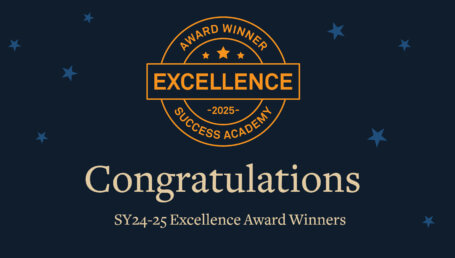
Most people don’t know this, but there are leading math educators whose celebrity status rivals Hollywood’s favorite movie stars. At least among math teachers! When Success Academy provided our high school math team with the chance to attend the annual National Council of Teachers of Mathematics conference in San Antonio, Texas— essentially the Oscars of math education — we could hardly wait.
One of the best things about being an educator at Success is that we’re given so many opportunities to be learners, too. My team and I appreciated becoming students again at the conference, with over 740 sessions and workshops to choose from. We were particularly enthralled by Dan Meyer, who boasts a Ted Talk video with over two million views and a 50,000-person Twitter following. Meyer famously revolutionized math textbooks and instruction by transforming classrooms into spaces of empowered problem solving.
One of the best things about being an educator at Success is that we’re given so many opportunities to be learners, too.
At Success, we’re also committed to teaching real-world mathematics. Starting in elementary school, our lesson plans focus on scholars teaching scholars using data derived from their own life experiences: In a lunchroom poll, just how many more scholars voted for apple juice over orange juice? We’ve believed from day one that our scholars should never have to wonder, “but why do I need to learn this?” Still, Meyer asked math educators to push beyond the obvious: to not only embed math in real-world problem solving, but to make those problems incredibly interesting to students. If kids think of math as a mundane punishment consisting of rote problem sets—regardless of how relevant those problem sets are in theory — then we’re just not teaching it right. He urges us to create captivating and creative “headaches” for students, and then help them discover that these headaches can disappear with the right math concept or tool.
We felt like cheering upon hearing Meyer speak — and yes, we took a selfie! His lesson spoke right to the heart of our objectives as a math team. We want to support all our scholars in viewing mathematics as a resource, and the exciting implication of Meyer’s approach is that it helps us eradicate the mythological division between the “math-minded” and the “creative” scholars.
When we next saw our 11th graders, we presented them with what we hoped would be a “headache” crazy and compelling enough to be worthy of Meyer’s approval. We asked them to decide which strain of zombies they would rather have infest our planet. Our scholars transformed into military consultants, armed with information on rates of growth. They immersed themselves in examining different variables, all while imagining life under a zombie attack as they bunkered down in the situation room to assess. Scholars discovered that one strain grew linearly, and the other, exponentially. They extended their thinking by coming up with questions like: How would the functions change if the military killed zombies at a certain rate? Does that influence which strain we choose to fight? They wrote letters to world leaders, explaining their recommendations and providing mathematical rationale behind their pleas.
Meyer’s talk was particularly refreshing in its call to elevate math empowerment to the next level. We certainly re-energized and re-conceptualized ourselves at the conference, not just as a team of teachers, but as a team of MATH teachers. I hope that one day, our scholars will be the ones who not only conquer zombies in the classroom, but also inspire groups of star-struck educators to gather, learn, and celebrate math.










